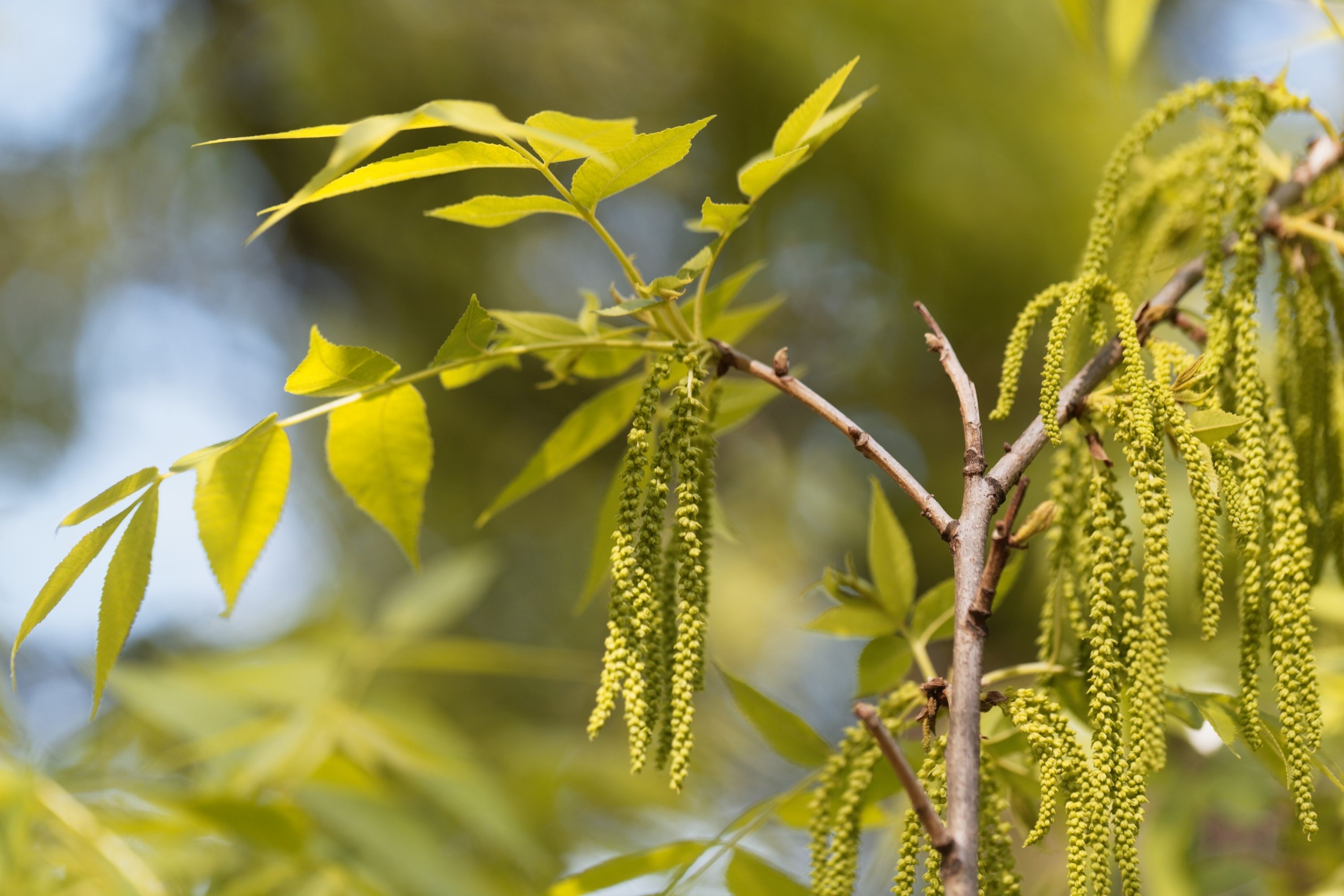Pecan tree
(Carya illinoinensis)

Description
Carya illinoinensis, commonly known as the pecan tree, is a large, deciduous tree native to North America. It is a member of the hickory family and is valued for its delicious nuts, which have a distinctively sweet and buttery flavor. Pecan trees can reach heights of up to 130 feet and can live for over 300 years. In this article, we will explore the various aspects of the Carya illinoinensis plant, including its botanical features, its cultural significance, its ecological role, and its economic importance. Botanical Features Carya illinoinensis is a large, deciduous tree that can reach heights of up to 130 feet and widths of up to 70 feet. The bark of the tree is a light gray color and has deep furrows that run vertically up the trunk. The leaves of the pecan tree are pinnately compound, meaning that they are made up of several leaflets arranged along a central axis. Each leaflet is lance-shaped, with a serrated edge and a pointed tip. The leaves can grow to be up to 20 inches long and 12 inches wide. The pecan tree is monoecious, meaning that it produces both male and female flowers on the same tree. The male flowers are arranged in long, drooping catkins, while the female flowers are small and inconspicuous. The flowers bloom in the spring, usually in April or May, before the leaves appear. Once pollinated, the female flowers develop into nuts, which are surrounded by a thick, green husk. The pecan nut itself is oval-shaped and can range in size from 1 to 3 inches in length. The shell of the nut is hard and thick, and the kernel inside is rich in oils and fats. Pecan nuts are usually harvested in the fall, after they have fallen to the ground and the husks have split open. Habitat and Range Carya illinoinensis, or the pecan tree, is native to North America, specifically to the southern United States, from Texas to Mississippi, and as far north as Iowa and Illinois. It is found in a variety of habitats, including river bottoms, floodplains, and upland areas. Pecan trees prefer deep, well-drained soil, and they require a significant amount of water to thrive. They are commonly found along riverbanks and in areas with high water tables. The trees can tolerate a range of temperatures and soil types, but they do not tolerate salty soils. In addition to its native range, the pecan tree has been introduced to other parts of the world, including South America, Africa, and Australia. However, it is still primarily grown in the United States, where it is an important agricultural crop. Cultivation Carya illinoinensis, or the pecan tree, is primarily cultivated for its delicious and nutritious nuts. Pecans are a popular ingredient in a wide range of food products, including candy, baked goods, and ice cream. Cultivation of pecan trees typically involves the following steps: Site selection: Pecan trees require deep, well-drained soil and a significant amount of water to thrive. They are commonly found in river bottoms and floodplains, but can also be grown in upland areas with irrigation. Propagation: Pecan trees are typically propagated through grafting, which involves taking a cutting from a mature tree and attaching it to a young seedling. Planting: Pecan trees should be planted in early spring or fall, and should be spaced at least 40 feet apart to allow for adequate root and canopy growth. Irrigation: Pecan trees require a significant amount of water to thrive, especially during the growing season. Irrigation systems should be designed to provide a steady supply of water to the trees. Fertilization: Pecan trees require regular fertilization to maintain healthy growth and nut production. Fertilizers should be applied in early spring and late summer, and should be tailored to the specific needs of the soil and the trees. Pest control: Pecan trees are susceptible to a variety of pests and diseases, including aphids, mites, and scab fungus. Integrated pest management (IPM) strategies can be used to minimize the use of chemicals and reduce the environmental impact of pest control. Harvesting: Pecan nuts are typically harvested in the fall, after they have fallen to the ground and the husks have split open. The nuts can be harvested manually or with mechanical equipment, and should be handled carefully to avoid damage. Overall, cultivation of pecan trees requires careful management of soil, water, and pest control, as well as attention to the specific needs of the trees. With proper care and attention, pecan trees can produce high-quality nuts for many years. Propagation Carya illinoinensis, or the pecan tree, is typically propagated through grafting, which involves taking a cutting from a mature tree and attaching it to a young seedling. This process ensures that the new tree will produce the same high-quality nuts as the parent tree. There are several methods of grafting that can be used to propagate pecan trees, including whip grafting, bark grafting, and cleft grafting. Each method involves cutting a small branch or bud from the parent tree and attaching it to the rootstock of the young seedling. The rootstock is typically a young seedling of a closely related species, such as the hickory tree, that is used as a base for the graft. The rootstock provides the new tree with a strong root system and a stable foundation for growth. The grafting process is typically done in the winter or early spring, when the trees are dormant. The young seedling is cut back to a small stem, and a small branch or bud from the parent tree is attached to the stem using a special grafting tape or wax. The graft is then covered with a protective sealant to prevent infection and to promote healing. Once the graft has taken hold, the young tree will begin to grow and develop into a mature pecan tree. The process of grafting ensures that the new tree will produce the same high-quality nuts as the parent tree, and can also help to increase the overall yield and quality of the pecan crop. Cultural Significance Carya illinoinensis has a long history of cultural significance in North America. The pecan tree was an important food source for many Native American tribes, who used the nuts in a variety of ways, including roasting, grinding into meal, and making into a sweetened pudding. The pecan tree was also considered to have spiritual significance and was used in many ceremonies and rituals. In the 19th century, the pecan tree became a popular ornamental tree in gardens and parks throughout the United States. Many large estates and public parks were landscaped with rows of pecan trees, and the nuts became a popular snack for visitors. Today, the pecan tree is an important part of the culinary culture of the Southern United States. Pecan pie, made with pecan nuts, is a traditional dessert that is often served during holidays and special occasions. Ecological Role Carya illinoinensis plays an important role in the ecology of North America. The pecan tree provides habitat and food for a wide variety of wildlife, including birds, squirrels, and other small mammals. The nuts are an important food source for many animals, and the trees themselves provide shelter and nesting sites. In addition, the pecan tree has important ecological functions in the ecosystem. The large, deep roots of the tree help to stabilize the soil and prevent erosion. The tree also helps to filter pollutants from the air and water, improving the quality of the surrounding environment. Economic Importance Carya illinoinensis is an important economic crop in the Southern United States. The pecan industry is a major contributor to the agricultural economy, generating billions of dollars in revenue each year. Pecan nuts are used in a variety of food products, including candy, ice cream, and baked goods. Pecan oil is also used in cooking and in the production of cosmetics and soaps. Pecan trees are also valued for their wood, which is used in furniture, flooring, and other construction materials. The wood is hard and strong, with a warm, reddish-brown color. Pecan cultivation is a complex process that requires careful management of soil, water, and pest control. The trees are usually propagated through grafting, which involves taking a cutting from a mature tree and attaching it to a young seedling. In recent years, there has been a growing interest in organic and sustainable pecan farming practices. Many farmers are adopting practices such as integrated pest management, cover cropping, and natural fertilization to reduce the environmental impact of pecan production. Conservation Status Carya illinoinensis, or the pecan tree, is not currently listed as a threatened or endangered species. It is a widespread and abundant tree species, with a large range and stable populations. However, like all plant species, pecan trees can be affected by habitat loss, climate change, and other environmental factors. In recent years, there has been growing concern about the impact of climate change on pecan production. Rising temperatures and changes in precipitation patterns can have a negative effect on the growth and health of pecan trees, which could have long-term implications for the pecan industry. In addition, the use of pesticides and other chemicals in pecan farming can have negative effects on the surrounding environment and on the health of wildlife that rely on pecan trees for food and habitat. To address these concerns, many farmers are adopting sustainable and organic farming practices, which can help to reduce the environmental impact of pecan production. Overall, while Carya illinoinensis is not currently considered a threatened or endangered species, its conservation is important for the preservation of the ecosystem services it provides and the economic benefits it generates. Continued research and conservation efforts are needed to ensure the long-term sustainability of pecan production and the health of the surrounding environment. Conclusion Carya illinoinensis, or the pecan tree, is a valuable and versatile plant that has played an important role in the cultural, ecological, and economic history of North America. Its delicious nuts, ornamental value, and ecological functions make it a beloved and important part of the landscape. As interest in organic and sustainable farming practices continues to grow, the pecan industry is poised to play an even larger role in the future of agriculture and conservation.
Taxonomic tree:







